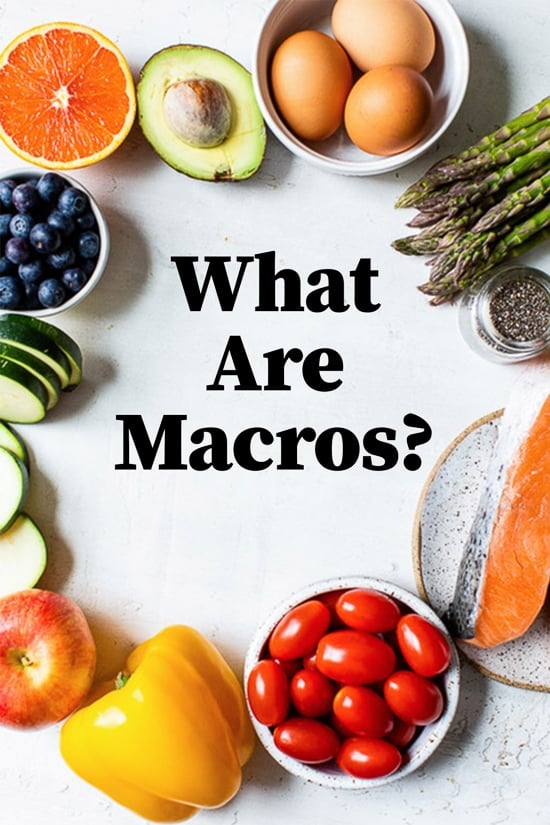posted February 2, 2021 by Gina
Macros or macronutrients are the three categories of nutrients you eat the most and provide you with most of your energy – protein, carbs and fats.
What are macros?
This is the question I have gotten most since I started counting macros a few months ago. As a woman over 40, losing weight hasn’t been as fast and easy for me as it was in my 20s or 30s. Counting macros have been eye opening for me. When I met Kendra Jarratt, I really started understanding macros and how it all works. I’ve gotten so many questions on the subject, I asked her to write a guest post and I am so happy she agreed! And I just want to say, I still love WW and will always be a huge advocate. But if you want to learn more about macros, read on!
A couple weeks ago Gina offered in her Instagram stories: “Ask me anything about macros and Kendra will answer them as a guest on my blog.” She received hundreds of questions and passed them along to me. I have selected the top themes that will give you a better understanding of macros in general.
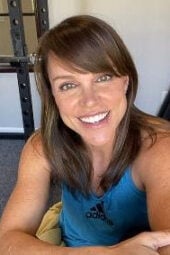 So, let me start by introducing myself. My name is Kendra Jarratt and I’m 47 years old. I’m a certified nutrition coach, personal trainer and behavior change specialist certified by the National Academy of Sports Medicine (NASM). I practiced this work through my 20s but left for a corporate career after becoming a single parent. A couple years ago, I was finally able to return to the industry I love to start my coaching business.
So, let me start by introducing myself. My name is Kendra Jarratt and I’m 47 years old. I’m a certified nutrition coach, personal trainer and behavior change specialist certified by the National Academy of Sports Medicine (NASM). I practiced this work through my 20s but left for a corporate career after becoming a single parent. A couple years ago, I was finally able to return to the industry I love to start my coaching business.
I provide all the ways to connect with me at the end of this article, including the app I use to help people directly.
WHY I DO THIS:
I started learning more about macros after digging myself out of a rough patch at 42. I experienced injuries, a slowing metabolism, horrible sleep, and a general loss of mojo. You can watch a recent YouTube video I did on this topic. I understand the struggle of adjusting to a changing body and mind and that’s what motivates me to help.
I later understood that I was experiencing the effects of perimenopause. I felt too young for anything with the word menopause in it, but it was good to know what I was dealing with. It is because of this experience that I have tremendous empathy for people who feel frustrated and lost about where to start. Especially for women my age; I want them to know there’s so much we can do to maintain our vitality and fitness.
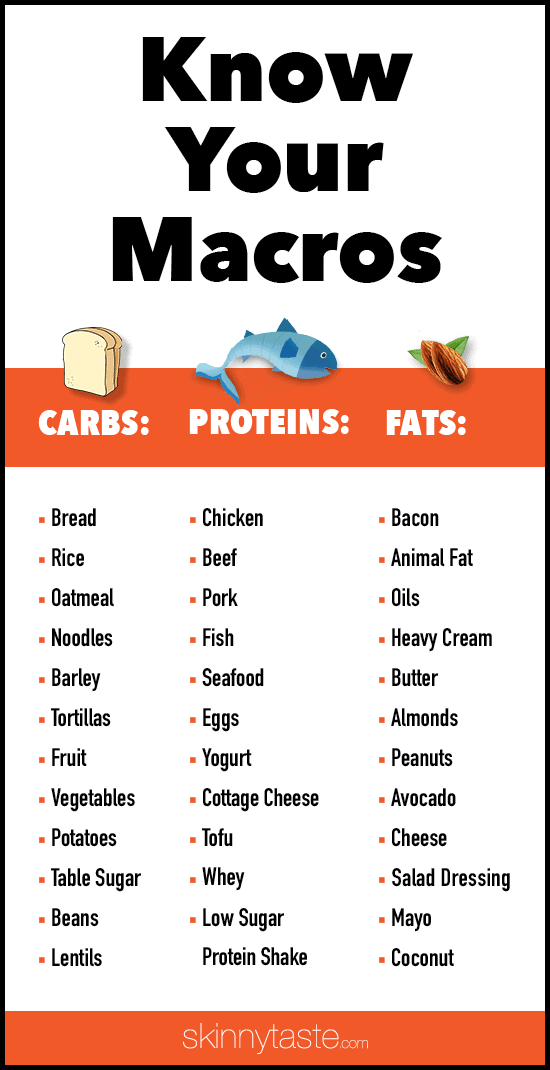
WHAT ARE MACROS?
Macros are not a fad diet or trend, but a way of better understanding the mix of macronutrients (macros being protein, carbohydrates, and fat) and total calories that are right for you and your goals.
Having worked with thousands of women through the app I use, I so often see the lightbulb moment when people recognize the freedom and flexibility of learning how to track macros. Tracking macros works for all ages and all fat loss goals. A physical transformation is always about mindset, being willing to learn, and consistency over time.
Alright, now let’s address some of your questions and keep things super simple:

What is a Macro and why should I be using them?
Macronutrients (macros) are simply protein, carbohydrates, and fat. Each macronutrient plays a different role in the body and it’s important to understand what you need and how they impact you.
Foods are made up of macronutrients and micronutrients– and so are we!!
We need micro and macro nutrients in our diet and supplements to live a healthy lifestyle and age well. The more we can understand what we are consuming and why, the less likely we are to continue to revisit the same problems.
- Macronutrients: Protein, carbohydrates, fat – think big picture nutrition
- Micronutrients: Individual vitamins and minerals like D, B, Calcium, Zink – think small picture (but very important) nutrition
To bring this often-boring-to-read information to life, I’m going to add stories of people you may connect with, and offer a way for you to start tracking your macros.
I will dive into:
- What each macro is and it’s function in your body
- Why they are important for you
- More questions from Gina’s followers including behavior around food
- Apps you can use to track
- How you can find me for help and support
A FEW SMALL CHANGES CAN MAKE A HUGE DIFFERENCE IN BODY COMPOSITION
48 years old – 28lb
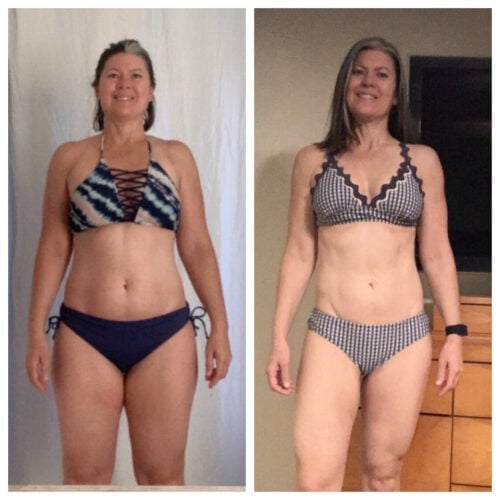
47 years old – 17lb
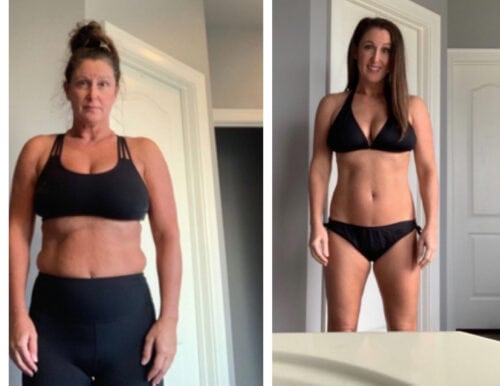
50 years old -28lb
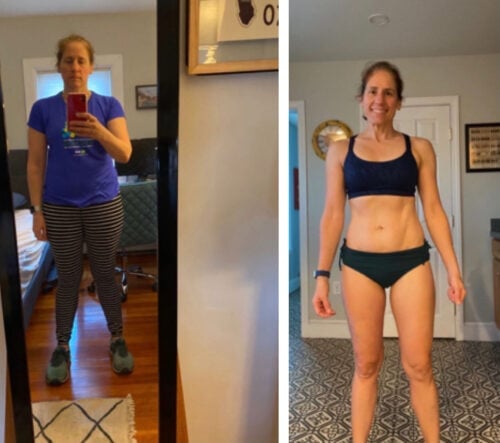
60 years old – 15lb
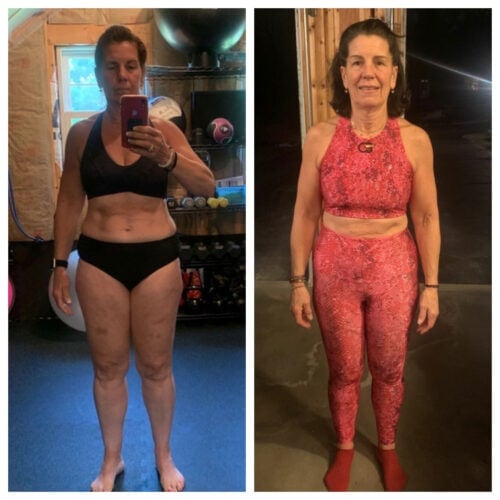
PROTEIN:
- “Protein is an important macronutrient that is involved in nearly all bodily functions and processes. It plays a key role in exercise recovery and is an essential dietary nutrient for healthy living. Protein and amino acids are primarily used to create bodily tissues, form enzymes and cellular transporters, maintain fluid balance, and more”. (NASM)
- Protein helps keep us feeling satiated, maintain and build lean muscle, and is much less likely to store itself as body fat than overconsuming carbohydrates and fat.
- The amount of protein a person needs depends on their activity level and goals, however the app I use starts by recommending 1g of protein/pound of your goal body weight and we adjust as we go depending on how a person is responding.
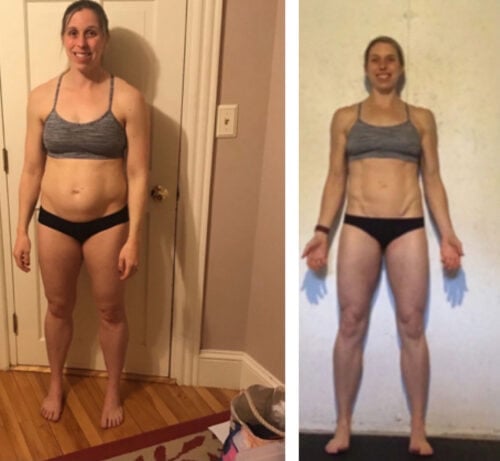 Heidi, 36, is a mom of two young ones and came to me after her second child wanting to feel better and stronger in her body. While she has been a fitness coach and was finishing her residency, she still needed support to change her body composition.
Heidi, 36, is a mom of two young ones and came to me after her second child wanting to feel better and stronger in her body. While she has been a fitness coach and was finishing her residency, she still needed support to change her body composition.
As Heidi reported, “adding more protein was the key in changing my body composition and managing cravings without feeling like I was starving and totally deprived”.
This speaks to the satiating nature of protein.
She will tell you that enough protein helped her physical body, while working on habits and triggers around food helped with the emotional and mental aspects of making any diet change. She worked on staying within the healthy boundaries of her macros without being terribly restrictive. As a result, she shed 10 pounds almost immediately, maintained her milk supply and energy levels due to the right mix of carbohydrates and fat, and found what she was looking for; herself.
CARBOHYDRATES:
- Carbohydrates are one of the two energy macros (fat being the other). Carbs have been feared tremendously in recent years as we all know. In my experience, there are probably some carbohydrates we should be afraid of, but complex carbohydrates, and even simple ones depending on our activity level, are important to consume for brain function, hormone balance, sustained energy levels and even help us get the body composition we want.
- Yes, they can help us! Nobody better outlines the need for how carbohydrates, protein and fat should fit into our aging bodies than Dr. Stacey Sims, author of my favorite book on women’s physiology, ROAR.
- The amount of carbohydrates a person should consume varies depending on total calorie needs, activity level and preference. Results also determine what’s right for you, but a macro based app will set your carbohydrates and allow you to adjust them as needed.
Sarah, 50 years old, thought of herself as following a keto diet and was terrified of carbs.
She worked out in the morning, fasted, and didn’t eat until about 11AM. She turned down all office snacks and brought a small salad with chicken to work every day.
However, Sarah lost her willpower by the evenings because in fact, our bodies do need carbs and she would guiltily give into those cravings at the end of the day.
We adjusted Sarah’s carbohydrate consumption to early in the day when her body could actually use them, followed the protein macro guideline, increased her water intake (120oz) and she started lifting weights (no you won’t get too big). She shed 20lb in a few months reporting “feeling like myself” again. Sticking to the protein goal and then adjusting the timing of her carbs and fats was the key to feeling her best.
FAT:
-
- Fats are the other energy macro. Similar to carbohydrates we need them for hormone balance, and energy. I’m oversimplifying, but it doesn’t have to be more complicated than that.
- The surge in higher fat diets is interesting to me. While I know it works for some people, I tend to work with people who are tired of fad diets (high fat, low fat, no carbs, fasting, you name it) that promise the body you’ve always wanted, but aren’t sustainable for a lifetime.
- “Is this sustainable for a lifetime?” is one of the questions we need to be asking ourselves no matter how we choose to approach a healthy nutrition lifestyle.
- The exact amount of fat a person should consume varies depending on total calorie needs and preference. A good macro based app will calculate it for you, and then adjust based on results,
Anne, 47, thought she was eating high protein through her handfuls of mixed nuts and, but as she started tracking, learned those are primarily a fat source. Just because something says “a great source of protein” on the package, does not mean it is. So, while she thought she was consuming healthy proteins she was actually over consuming fat. Her belly fat was increasing, and her energy levels were at risk. She thought it was all age related, but that’s usually only part of the story.
Check out this super simple list of protein sources I created. You can find these anywhere, but I’ve got a great post in my private Facebook group, Team Strong Life, with a helpful list and some context around it.
Once Ann started tracking her macros, she had her ah-ha moment.We learned that 80% of her diet was from fat. She started focusing on lean protein and a general balance of nutrient dense foods. Much like Heidi, her body fat released, her sleep improved, and she took a nice long break from wine. She went from feeling like total garbage, to having tons of energy.
WHERE DOES WINE FIT IN?
Of course, we’ve all heard of empty calories, like wine for example, that cost us calories, but don’t provide much nutritional value.
Alcohol is a hot button issue. I’m not going to make proclamations about what your relationship to alcohol should be. In the context of nutritional goals however, it will likely serve you to put the wine down for just a second. I did it in June after realizing that it was impacting my sleep and recovery in undeniable ways. I was afraid to cut it out but as it turns out, even sans alcohol, I’m still fun and I still have fun. That’s where I am now. Alcohol can be part of an overall healthy lifestyle and for many people it is.
What app is best to calculate my macros?
The best place to start is to find a macro based app supported by both a certified nutrition coach and registered dietitian who have visibility into your food and fitness journal and can provide feedback. I advise people through an app called 1st Phorm backed by registered dietitian, Jeremy Mullins, MS., RD., as a resource. I’ll share how to get connected with me directly in the app at the end of this blog.
If you use The 1ST PHORM app, we can help you customize and adjust your macros based on your goals and results week to week.
As your advisor, which is one of the major benefits of this app, I can see your food journal and provide feedback as long as you’re using the premium version of the app – $5/month.
If you’re using My Fitness Pal, you can adjust your food journal to see macros for each meal.

How to balance between paying attention to macros but not obsessing over every bite?
We’re all trying to find a balance here. No matter what app you use or lifestyle you’re trying to adopt, there’s a learning curve and a period of time and effort we need to invest. The initial time investment can seem like a lot, but that’s with anything we have to learn, isn’t it? More time up front, no big deal in a few weeks.
KNOWLEDGE IS POWER:
If you have a goal and you’re on a mission, we can look at food tracking as information rather than restriction. For me, I want to know what I’m consuming to understand what makes me feel the best. I don’t track all the time. I run four, 8-week challenges a year in my private Facebook group and I track my food during those so my head is in the game, but then move to intuitive eating as well when I need a break.
It’s natural to feel “obsessed” as you’re learning, but knowledge is power. Again, if you’re where you want to be, then it’s not necessary. But if you’re not where you want to be, and you are telling yourself that “little bites don’t matter,” I can tell you they do.It all matters and counts and once you see it, it can be empowering. It’s a mindset shift.
So many people struggle to track it all. It’s really hard to face a night binge. Yikes. Most of us want to just start fresh the next day, but I coach and encourage, almost daily, how empowering it is to face your choices if you really want results. Just own it, understand why you do what you do, learn, adjust and move on.
Also, I tend to think there are worse things to obsess about if you’re on a mission to change your body composition and learn. Let’s be honest, we obsess either way, don’t we? We obsess and beat ourselves up when we make poor choices. This work is about being more intentional about your choices which can require some extra focus for a while.

Are you relying on Skinnytaste recipes?
I love Skinnytaste (ST). I’ve been recommending it to my clients as the go-to recipe website for a while now. Gina is much more creative than most of us and spends time with food and flavors so that we don’t have to. I value that. I do simple meal prep every week at my house and love to use the inspiration of ST.
I don’t love to cook, but I love food, being strong, being lean, feeling great and coaching others how to get what they want. The real reason I spend time doing meal prep is because I don’t want to make a million food choices a day, especially when I’m hungry. Remember, keeping things simple is key.
Most of my meals are similar for breakfast and lunch, and then we switch it up at dinner with new simple recipes. My go-to dinner is a piece of fish or chicken on a beautiful salad, but I’m also a huge fan of ST air fryer and Instant Pot recipes. With macros, there’s a lot of flexibility with food. Just keep the junk at bay and think nutrient dense!

Do you have to hit your macros exactly everyday?
No. I mentioned this earlier, but look for ranges and be ok with not hitting check marks every day on whatever app you use. I have people who thrive and love nailing all macros every day, but most people don’t hit them all and still get results. Progress over perfection, right?
Assuming you’re tracking macros to reach your body composition goals and feel better, here’s a way to keep things simple overall.
SIMPLE:
- Track your food with full transparency
- Prioritize protein
- Stay within about a 10% range of your calories and macros
- Drink your water
- Move every day, even if it’s a walk
THAT’S IT. When things feel complicated, go back to basics.
How do you track macros when you go out to dinner?
This is a great question. If you’re going out to dinner, plan your day around it. Put in what you think you might eat and adjust accordingly in the app. It’s really eye opening to do that and you will learn how easy it is to overeat.
Macronutrients, whether you’re eating out or not, are macronutrients. What’s different is the way food is prepared. Make some room for butter and oil!
Put the main ingredients in the app and try not to get too stressed about the details. This is another reason I look for ranges.
Also, most apps have a list of common foods like “cheeseburger” which will calculate macros for you. While it might not be exact, again, we’re looking for directional accuracy.
PRO-TIP?
If you find something that works, you feel great, and you have the physique and energy you want, KEEP DOING IT!!
Know that a healthy lifestyle and any physical transformation is about consistency over time, transparency, and choices.
- Step 1: Download the 1st Phorm app on your phone using my link.
- Step 2: Upgrade to premium to customize macros, hear announcements from me, message me, get access to LIVE streaming information and workouts. It’s about $5/month and well worth it to have an advisor on the other side helping you reach your goals!
- Step 3: Make sure I’m your advisor. If I’m not, drop yours and add me – kendrajarratt
- Step 4: Send me a message through the chat feature and say “what’s up!!”
- Step 5: Go to your dashboard and you’ll see your macro and calorie recommendation. Make sure your nutrition settings are “calorie/macro counting”. As I mentioned earlier, the macro and calorie recommendations are based on your current weight, goals, and activity level. They can always be adjusted and I can help with that.
- Step 6: GET STARTED! Just start tracking your food and you’ll start to see where you fall within the recommended macros right on one screen. You will do weekly assessments which send your food journal to me and my team for review and feedback.
- Step 7: Join my private Facebook group, Team Strong Life, where I spend a lot of time connecting with my people. I do LIVE workouts, nutrition and motivation talks as well.
TO TRACK IN MFP:
- Step 1: Download the app, or adjust your settings if you already use MFP.
- Step 2: To see your macros you’ll need to select that option once in your food journal. You can toggle back and forth to see a calorie view or a macro view. MFP has the user adjust macro settings.
To Connect with Kendra:
Instagram: @kendra.jarratt (see dozens more transformations)
Facebook: Kendra Jarratt Coaching
Private Facebook Group: Team Strong Life
TikTok: @kendra.jarratt
YouTube: Kendra Jarratt
Website: www.kendrajarratt.com
Email: info@kendrajarratt.com
